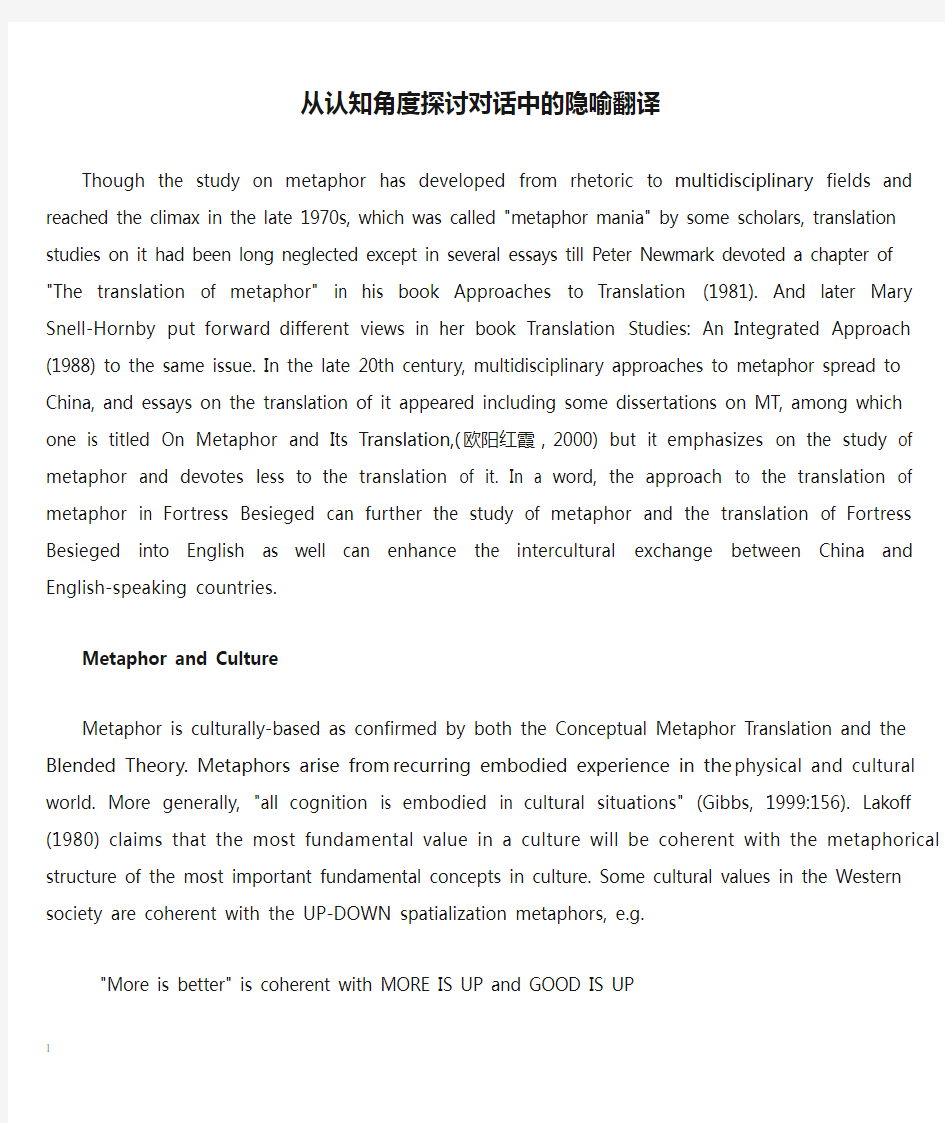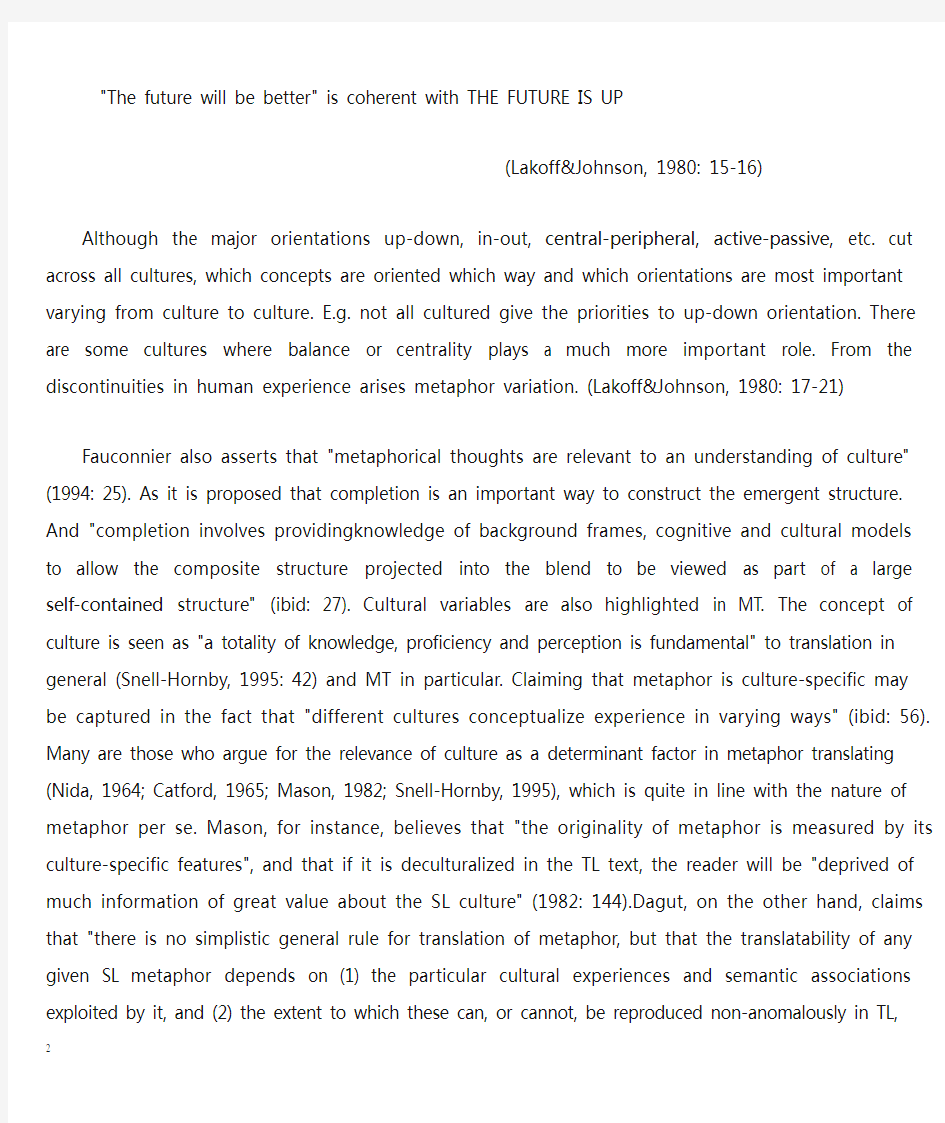

从认知角度探讨对话中的隐喻翻译
Though the study on metaphor has developed from rhetoric to multidisciplinary fields and reached the climax in the late 1970s, which was called "metaphor mania" by some scholars, translation studies on it had been long neglected except in several essays till Peter Newmark devoted a chapter of "The translation of metaphor" in his book Approaches to Translation (1981). And later Mary Snell-Hornby put forward different views in her book Translation Studies: An Integrated Approach (1988) to the same issue. In the late 20th century, multidisciplinary approaches to metaphor spread to China, and essays on the translation of it appeared including some dissertations on MT, among which one is titled On Metaphor and Its Translation,(欧阳红霞,2000) but it emphasizes on the study of metaphor and devotes less to the translation of it. In a word, the approach to the translation of metaphor in Fortress Besieged can further the study of metaphor and the translation of Fortress Besieged into English as well can enhance the intercultural exchange between China and English-speaking countries.
Metaphor and Culture
Metaphor is culturally-based as confirmed by both the Conceptual Metaphor Translation and the Blended Theory. Metaphors arise from recurring embodied experience in the physical and cultural world. More generally, "all cognition is embodied in cultural situations" (Gibbs, 1999:156). Lakoff (1980) claims that the most fundamental value in a culture will be coherent with the metaphorical structure of the most important fundamental concepts in culture. Some cultural values in the Western society are coherent with the UP-DOWN spatialization metaphors, e.g.
"More is better" is coherent with MORE IS UP and GOOD IS UP
"The future will be better" is coherent with THE FUTURE IS UP
(Lakoff&Johnson, 1980: 15-16)
Although the major orientations up-down, in-out, central-peripheral, active-passive, etc. cut across all cultures, which concepts are oriented which way and which orientations are most important varying from culture to culture. E.g. not all cultured give the priorities to up-down orientation. There are some cultures where balance or centrality plays a much more important role. From the discontinuities in human experience arises metaphor variation. (Lakoff&Johnson, 1980: 17-21) Fauconnier also asserts that "metaphorical thoughts are relevant to an understanding of culture" (1994: 25). As it is proposed that completion is an important way to construct the emergent structure. And "completion involves providingknowledge of background frames, cognitive and cultural models to allow the composite structure projected into the blend to be viewed as part of a large self-contained structure" (ibid: 27). Cultural variables are also highlighted in MT. The concept of culture is seen as "a totality of knowledge, proficiency and perception is fundamental" to translation in general (Snell-Hornby, 1995: 42) and MT in particular. Claiming that metaphor is culture-specific may be captured in the fact that "different cultures conceptualize experience in varying ways" (ibid: 56). Many are those who argue for the relevance of culture as a determinant factor in metaphor translating (Nida, 1964; Catford, 1965; Mason, 1982; Snell-Hornby, 1995), which is quite in line with the nature of metaphor per se. Mason, for instance, believes that "the originality of metaphor is measured by its culture-specific features", and that if it is deculturalized in the TL text, the reader will be "deprived of much information of great value about the SL culture" (1982: 144).Dagut, on the other hand, claims that "there is no simplistic general rule for translation of metaphor, but that the translatability of any given SL metaphor depends on (1) the particular cultural experiences and semantic associations exploited by it, and (2) the extent to which these can, or cannot, be reproduced non-anomalously in TL, depending on the degree of `overlap' in each particular case" (1976: 32). Elsewhere, Dagut proposes that "what determines the translatability of a SL metaphor is not its `boldness' or `originality' but rather the extent to which the cultural experience and lexical matrices on which it draws are shared by speakers of the particular TL" (1987: 82). Dagut thus explains that "the untranslatability of metaphor is due to the absence of the cultural reference of a SL metaphor in the TL, the cultural and lexical specifics of the SL, or simply compactness of lexical items" (1987: 81). However, Van Den Broeck takes the case of metaphor as a limit on translatability as a whole, and argues that the translatability of metaphor is inversely proportional to the amount of "information (specifically cultural) manifested by the metaphor and the degree to which this information is structured in a text" (1981: 84). Dobrzynska claims that the "interpretation of metaphor is strongly culturally conditioned" (1995: 598-9).
To be simple, metaphor is interpreted on the base of the resemblance between the tenor and the vehicle, the resemblance in
many cases is cultural-specific. To interpret this kind of metaphor requires the relevant knowledge of this culture, including, as has been mentioned, allusion that reflects the relevant historical, literary or legendary event and terms, and idioms and proverbs that reflect the conventional way of saying. In the process of translation, the translators have to assess the cultural condition of the target readers in order to adopt proper approaches and techniques.